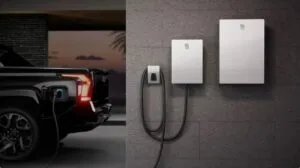Dive Brief:
- The California Energy Commission may require “any weight class” of battery-electric vehicles to have vehicle-to-grid, or V2G, charging capabilities under a bill passed Aug. 31 by the California Senate.
- The bill would give CEC broad authority to determine the scope, timing and technical aspects of the bidirectional charging mandate and could in theory render California’s EV fleet capable of “providing the equivalent of several hours of the state’s daily energy demand,” ClearView Energy Partners said in a Sept. 3 research note. Gov. Gavin Newsom, D, is expected to sign the measure this month, ClearView said.
- The bill represents a “less-prescriptive alternative” to a similar bill passed last year by the California Senate that would have required all EVs sold in California to have bidirectional charging capabilities by the 2030 model year, ClearView said.
Dive Insight:
California S.B. 59 is the latest state-level effort to advance bidirectional EV charging capabilities and distributed energy resources more broadly.
In May, Maryland enacted a package of clean energy legislation to: spur residential and commercial solar adoption to meet a state mandate for solar generation to account for 14.5% of overall electricity generation sales by 2028; require Maryland utilities to develop plans for bidirectional EV charging and virtual power plant networks by next year; and implement time-of-use electricity tariffs to incentivize off-peak power consumption by 2028.
A Colorado law enacted shortly after the Maryland package requires Xcel Energy, the state’s largest electric utility, to create a VPP program with a performance-based compensation tariff by February while taking steps to streamline its grid interconnection process and upgrade distribution networks to ease capacity constraints.
Xcel and Fermata Energy are also pursuing a potentially pathbreaking bidirectional EV charging pilot program in Boulder, Colorado, as part of the utility’s 2021-23 transportation electrification plan. The pilot will advance Xcel’s understanding of the bill impacts and resiliency benefits of bidirectional charging assets, the utility said.

While the Maryland and Colorado efforts focus on state utility territories or utility customer cohorts, S.B. 59 could impact the pace and scale of V2G-capable vehicles on a national level given the size of California’s automotive market.
“California’s vehicular heft could lead manufacturers to sell California-ready, bidirectional V2G-models more broadly and maybe even on a nationwide basis,” ClearView said in its note.
A similar dynamic already exists on vehicle emissions standards thanks to a federal Clean Air Act waiver that allows California to set its own, more stringent requirements. Under that authority, the California Air Resources Board in 2022 prohibited the sale of light-duty internal combustion vehicles from 2035 onward; 18 states have since followed suit, according to the California Air Resources Board.
S.B. 59 could advance the California Air Resources Board’s clean air goals by reducing the use of diesel generators during power outages, California State Sen. Nancy Skinner, D, a bill sponsor, said in a statement.
V2G-capable EVs could also relieve strain on California’s grid and reduce blackout risk during periods of high demand caused by extreme weather, Skinner said.
Notwithstanding S.B. 59 or possible future action by the CEC, some automakers are expanding their fleets’ bidirectional capabilities. Some popular EVs, including the Nissan Leaf and Ford F-150 Lightning, are already V2G-capable, and Tesla has announced plans to equip all of its vehicles with bidirectional charging capabilities by next year, Skinner said.
But the ambiguous language at the heart of S.B. 59 — that the CEC “may require any weight class of battery electric vehicle to be bidirectional-capable if it determines there is a sufficiently compelling beneficial bidirectional-capable use case to the battery electric vehicle operator and electrical grid” — leaves considerable uncertainty about the law’s future impact, ClearView said. The law includes no timeline for CEC to act, and “‘any weight class’ … could theoretically cover the expansive terrain between ‘none’ and ‘all,’ it said.
Still, S.B. 59’s impacts could be significant for California’s utilities and grid. Should CEC mandate bidirectional charging in light-duty vehicles beginning in 2027, the roughly 2 million EVs expected to be sold in California that year could in theory add 119 GWh of power to the grid — 3.6 times more than the 33 GWh of battery duration on the state’s grid today and about 4.4 hours of average 2023 electricity demand, ClearView said.
V2G law could grow California battery capacity 119 GWh in 2027: ClearView Energy (yahoo.com)
Leave a Reply